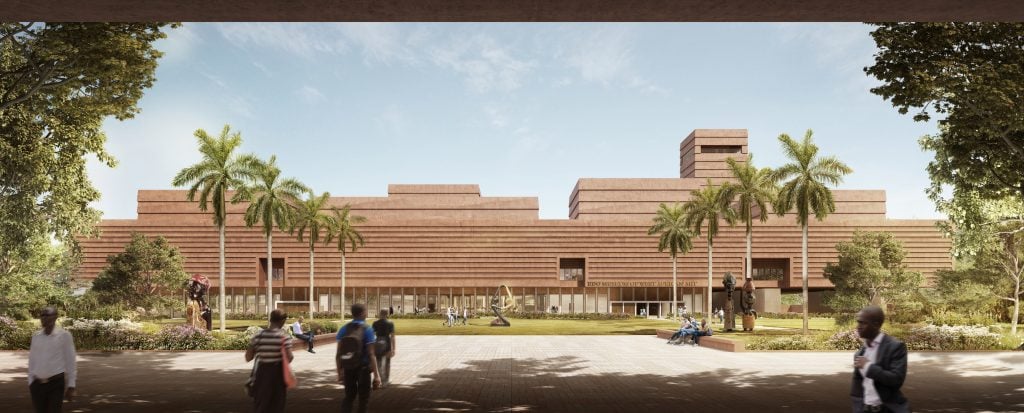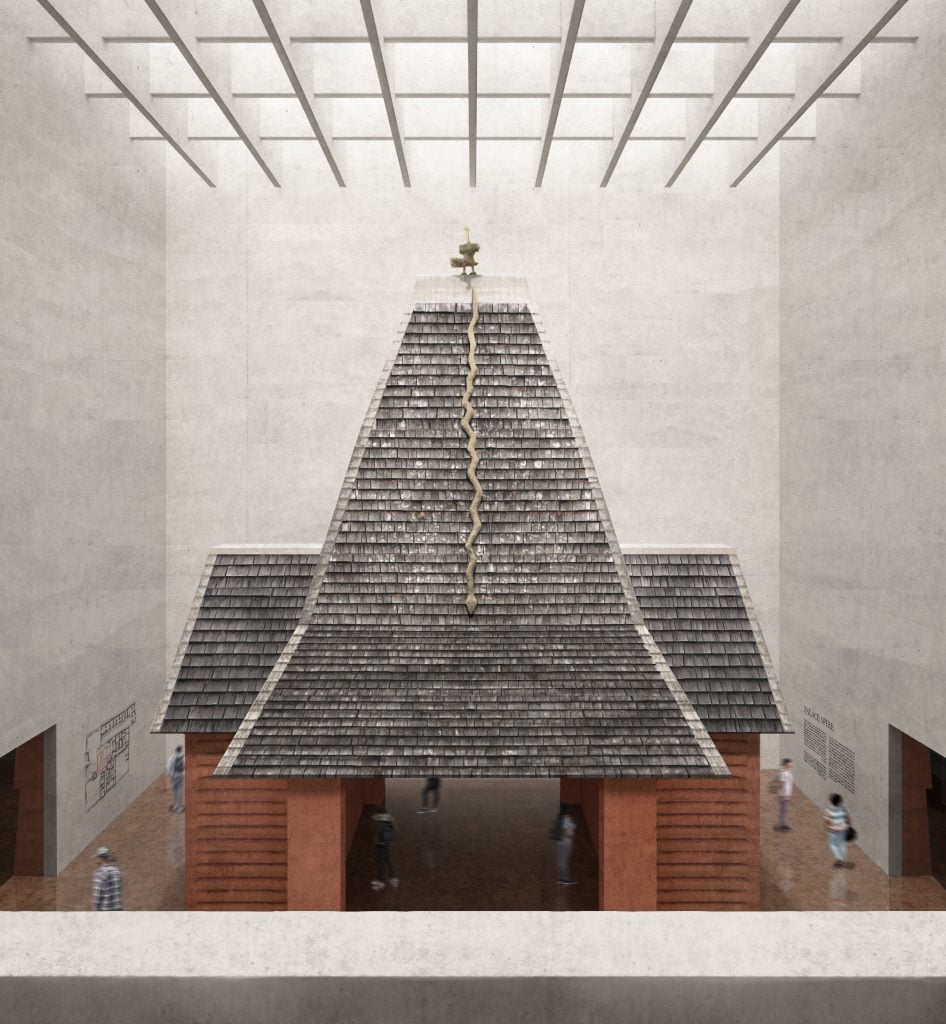New Benin Museum To Highlight Glory Of The Benin Empire - Politics - Nairaland
Nairaland Forum / Nairaland / General / Politics / New Benin Museum To Highlight Glory Of The Benin Empire (357 Views)
London Museum To Return 72 Artifacts To Nigeria. / Unrest In New Benin Market As A Hausa Man Stabbed An Igbo Trader To Death (video / We Welcome The New Benin Ikwere People (2) (3) (4)
| New Benin Museum To Highlight Glory Of The Benin Empire by Rosskivvyy: 9:34pm On Nov 17, 2020 |
Starchitect David Adjaye’s Museum of West African Art in Nigeria Will Be Dramatically Built Into the Ruins of the Former Benin Palace The British Museum is working with Nigerian officials on an ambitious $4 million excavation that will lay the groundwork for the new museum. Naomi Rea, November 16, 2020   The forthcoming Edo Museum of West African Art (EMOWAA) in Benin City, Nigeria, is sitting atop a treasure trove of cultural heritage. Valuable archaeological remains from the former Kingdom of Benin are buried beneath the proposed site for the forthcoming David Adjaye-designed museum, which will physically incorporate ruins as well as art objects from the former kingdom that have never been fully investigated. In an effort to foster greater cultural ties with Nigeria against the backdrop of a grisly colonial history—including the mass looting of the Benin royal palace by British forces in the 19th century—the British Museum is helping teams on the ground excavate the ruins as part of an ambitious $4 million project beginning in 2021. Unlike the cultural artifacts that were taken in the 19th century, which are today spread across many museums in Europe and the US, objects unearthed as part of the five-year EMOWAA Archaeology Project will remain in Nigeria, and become part of the forthcoming museum’s collections and displays. The British Museum’s director, Hartwig Fischer, said in a statement that the institution was honored to help investigate the history of the Kingdom of Benin to advance a “shared understanding of cultural heritage.” He added that the project “will surely become one of the most significant museum initiatives in the coming decades.” The British Museum currently holds more than 900 Benin objects in its collection, and around 11 percent of them are on permanent public display. An international consortium of museums known as the Benin Dialogue group, of which the British Museum is part, is working to support the construction of the museum, which would be a major step towards enabling a permanent display of Benin art. The British Museum has promised it would consider lending objects to the new museum, although it maintains that a full transfer of ownership would not be legally possible. Other partners working on the archeology project include the Legacy Restoration Trust, which helped the British Museum raise money for the excavation; the Benin Royal Court; the Government of Edo State; and the National Commission for Museums and Monuments. Adjaye, the museum’s architect, said he hopes the building will establish a new paradigm for what museums in African can be. He has thus far proposed incorporating the surviving remains of walls, moats, and gates of the historic city into the new building. |
| Re: New Benin Museum To Highlight Glory Of The Benin Empire by LawLab247: 9:42pm On Nov 17, 2020 |
Ok |
| Re: New Benin Museum To Highlight Glory Of The Benin Empire by Rosskivvyy: 9:47pm On Nov 17, 2020 |
The Benin empire was one of the oldest and most highly developed states in west Africa, dating back to the 11th century. The Guinness Book of Records (1974 edition) described the walls of Benin City and its surrounding kingdom as the world’s largest earthworks carried out prior to the mechanical era. According to estimates by the New Scientist’s Fred Pearce, Benin City’s walls were at one point “four times longer than the Great Wall of China, and consumed a hundred times more material than the Great Pyramid of Cheops [in Egypt]”. Situated on a plain, Benin City was enclosed by massive walls in the south and deep ditches in the north. Beyond the city walls, numerous further walls were erected that separated the surroundings of the capital into around 500 distinct villages.  Pearce writes that these walls “extended for some 16,000 km in all, in a mosaic of more than 500 interconnected settlement boundaries. They covered 6,500 sq km and were all dug by the Edo people … They took an estimated 150 million hours of digging to construct, and are perhaps the largest single archaeological phenomenon on the planet”. Benin City was also one of the first cities to have a semblance of street lighting. Huge metal lamps, many feet high, were built and placed around the city, especially near the king’s palace. Fuelled by palm oil, their burning wicks were lit at night to provide illumination for traffic to and from the palace. When the Portuguese first “discovered” the city in 1485, they were stunned to find this vast kingdom made of hundreds of interlocked cities and villages in the middle of the African jungle. They called it the “Great City of Benin”, at a time when there were hardly any other places in Africa the Europeans acknowledged as a city. Indeed, they classified Benin City as one of the most beautiful and best planned cities in the world. In 1691, the Portuguese ship captain Lourenco Pinto observed: “Great Benin, where the king resides, is larger than Lisbon; all the streets run straight and as far as the eye can see. The houses are large, especially that of the king, which is richly decorated and has fine columns. The city is wealthy and industrious. It is so well governed that theft is unknown and the people live in such security that they have no doors to their houses.” [img]https://prolificstella.files./2015/09/esigoba-of-benin.jpg[/img] At the centre of the city stood the king’s court, from which extended 30 very straight, broad streets, each about 120-ft wide. These main streets, which ran at right angles to each other, had underground drainage made of a sunken impluvium with an outlet to carry away storm water.... “Houses are built alongside the streets in good order, the one close to the other,” writes the 17th-century Dutch visitor Olfert Dapper. “Adorned with gables and steps … they are usually broad with long galleries inside, especially so in the case of the houses of the nobility, and divided into many rooms which are separated by walls made of red clay, very well erected.” Dapper adds that wealthy residents kept these walls “as shiny and smooth by washing and rubbing as any wall in Holland can be made with chalk, and they are like mirrors. The upper storeys are made of the same sort of clay. Moreover, every house is provided with a well for the supply of fresh water”. Family houses were divided into three sections: the central part was the husband’s quarters, looking towards the road; to the left the wives’ quarters (oderie), and to the right the young men’s quarters (yekogbe). Daily street life in Benin City might have consisted of large crowds going though even larger streets, with people colourfully dressed – some in white, others in yellow, blue or green – and the city captains acting as judges to resolve lawsuits, moderating debates in the numerous galleries, and arbitrating petty conflicts in the markets. The early foreign explorers’ descriptions of Benin City portrayed it as a place free of crime and hunger, with large streets and houses kept clean; a city filled with courteous, honest people, and run by a centralised and highly sophisticated bureaucracy. What impressed the first visiting Europeans most was the wealth, artistic beauty and magnificence of the city. The city was split into 11 divisions, each a smaller replication of the king’s court, comprising a sprawling series of compounds containing accommodation, workshops and public buildings – interconnected by innumerable doors and passageways, all richly decorated with the art that made Benin famous. Source - GuardIan UK |
| Re: New Benin Museum To Highlight Glory Of The Benin Empire by leofab(f): 10:45pm On Nov 17, 2020 |
A step in the right direction 1 Like |
| Re: New Benin Museum To Highlight Glory Of The Benin Empire by Seerade029: 10:52pm On Nov 17, 2020 |
Rosskivvyy: This was in the past. let them goan developed themselves now. |
(1) (Reply)
#lekkimassacre: CNN Investigates, Claims The Army Killed and Injured Many / FG hails military, police over conduct during #EndSARS protests / BREAKING: Senator Elisha Abbo Dumps PDP For APC
(Go Up)
| Sections: politics (1) business autos (1) jobs (1) career education (1) romance computers phones travel sports fashion health religion celebs tv-movies music-radio literature webmasters programming techmarket Links: (1) (2) (3) (4) (5) (6) (7) (8) (9) (10) Nairaland - Copyright © 2005 - 2024 Oluwaseun Osewa. All rights reserved. See How To Advertise. 24 |